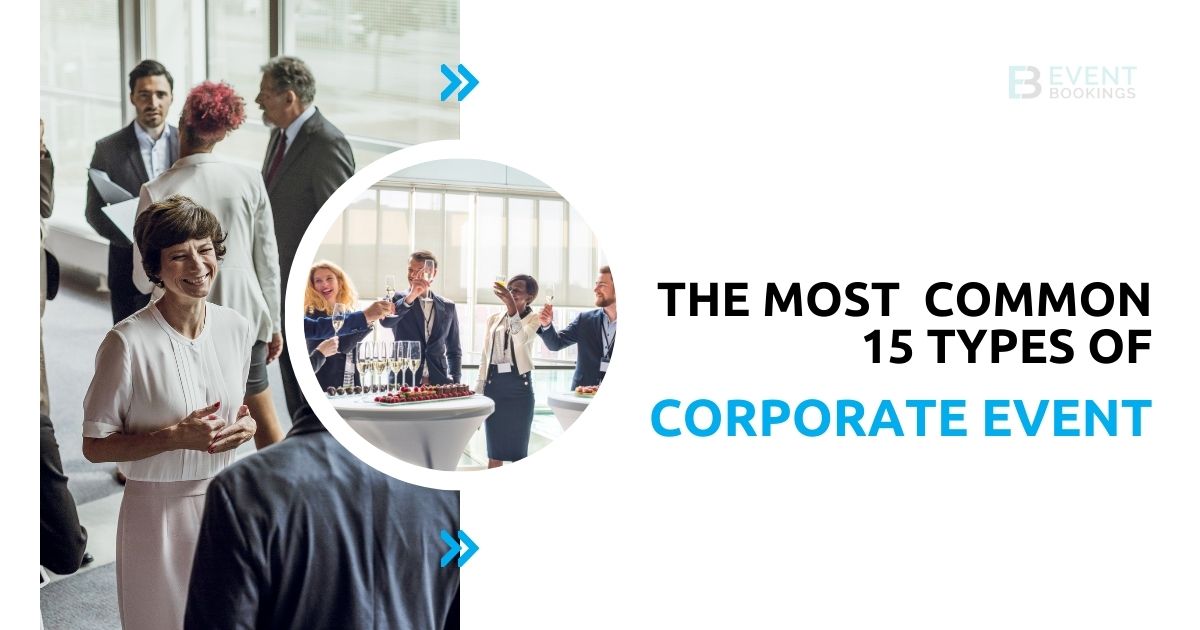Corporate events are workplace gatherings that bring together business teams in informal, offsite settings. They give a vital respite from routine while providing an opportunity to have fun, cooperate, participate in team-building activities, and network with colleagues.
Several corporate events may be hosted. These might be anything from conferences to team bonding. The purpose of your event will help you decide what style of event to hold.
First, determine your target audience, whether they are clients, industry leaders, or team members, and then design the event’s objectives. Once you have this, it will be easy to pick the type of event to organize.
If you’re unsure where to start, this article can help you with the most common corporate events you can arrange for each stakeholder.
15 Types of corporate events
Corporate events take various forms and sizes, each serving a unique purpose. The key to selecting the best one for your business is understanding what you’re trying to achieve. Here is a list of 15 corporate events you can consider as future options.
1. Tradeshows
Tradeshows are big indoor or outdoor displays where firms in a certain industry pay to showcase their products/services. As large corporate events, they can cost tens of thousands of dollars to host. Therefore, most businesses attend to those already existing in their sector.
Whether you host or attend tradeshows, the benefits are the same: you can interact with new clients, network with potential partners, and observe what your rivals are doing. If you decide to hold one, you must acquire sponsors and a location, publicize the event, and invite guest speakers. It requires significant effort, but the end effect will be to consolidate your reputation as an industry leader.
2. Company Retreats
Company retreats are among the most effective types of business activities. During a retreat, co-workers leave the office for distraction-free socializing and team-building, with some work assignments tossed in for good measure.
The result is a powerful approach to connect more intimately and build better relationships. Team communication improves, and changing scenery does wonders for morale. Ultimately, everyone returns to the office feeling rejuvenated and energized.
3. Board meetings
Board meetings are more private and formal corporate gatherings at which the board of directors meets to review the company’s financial status and make crucial business decisions. Strategic planning, risk management, and corporate social responsibility are just some topics that may arise.

Board meetings are held semi-regularly, such as every quarter, biannually, or yearly, as well as in unusual circumstances or during emergencies. What about their format and duration? These can also change based on the predetermined agenda and the quantity of subjects to be covered.
4. Product launches
Do you have a new product or service ready to enter the market? Want to grab the interest of potential consumers and attract media coverage? Consider hosting a product launch as your next company event.
A well-executed launch, a vital milestone in the product development process, accomplishes all of these desirable results, as well as newfound brand exposure. These events take place in a variety of settings, from tiny conference rooms to large convention centres, and often include a mix of marketing and public relations efforts. Expect product demos, talks, interviews, and other promotional endeavours.
If you are interested, you take a quick look at guide to plan a successful product launch event
5. Conferences
Conferences, like tradeshows, are popular large-scale business events that help brands engage with their target customers while providing networking and cooperation opportunities. The fundamental distinction is in purpose. Whereas tradeshows have a significant sales component, conferences focus on providing valuable information to the audience.
They often last several days, are held in hotels or conference centres, and include speakers, seminars, panel discussions, and sessions on topics such as industry trends or difficulties addressed by the firms in attendance.
6. Holiday parties
Holiday parties are fun workplace occasions where people may let their hair down and unwind. However, there are other ways for the organization to express thanks for its employees’ efforts. You might think of them as “thank you” in the shape of company-sponsored lunches, celebratory dinners, cocktail parties, and so on.

Regarding incentives, office holiday parties promote team cohesiveness and boost workplace culture. Employees mix outside the workplace, connecting on a more personal level and enjoying activities ranging from energizer games and karaoke to live entertainment.
However, it is important that these events be as inclusive as possible, so while planning them, consider everyone’s interests, preferences, and diverse cultural/religious beliefs.
7. Networking event
Organize a laid-back after-hours networking event for local entrepreneurs by collaborating with a trendy restaurant, brewery, or tapas establishment. Encourage your staff to pursue their interests and connect with people across a range of sectors while you elevate your company’s profile in the community. Collaborate with your local Chamber of Commerce to organize and conduct frequent networking events, which can help you forge stronger bonds with other businesses in your area. Incorporate speed networking sessions into conference schedules to boost attendance and elevate the event’s perceived worth.
8. Charity events
Charity events include everything from gala dinners and auctions to benefit concerts and fun runs, and their goal is to generate money for a specific cause, give back to the community, and demonstrate the company’s commitment to social responsibility.
To plan one, pick a cause or organization that shares your company’s values and objectives. Want to obtain your employees’ buy-in? Survey them beforehand to see which issues they are most enthusiastic about. From there, you may create event goals, such as how much money you want to raise and how many people you need to attract.
9. New experience day
What have you and your co-workers or employees never done before? Even better, include three to five activities you have never engaged in. Once your team has responded to those questions, new experience days push you to make things right by crossing those things off your collective bucket list!
For instance, the team members may have yet to visit a specific area of town, bowl, or eat German food. After spending the day eating currywurst and schnitzel, you would find a bowling alley in the region in question.
In any case, attempt to select inexpensive, simple, and easily accessible experiences. After identifying and completing them, you’ll make new memories and feel like a happier, more united group.
10. Cross department mixer
Employees at large companies may work in entire departments without ever meeting in person. If that’s the situation in your company, a cross-departmental mixer could help. These business gatherings, sometimes called interdepartmental socials, invite two or more departments to mingle outside the workplace.
There is no limit to what they could involve. You could throw a pizza party, plan a quiz night, grab dinner, or head to a local pub for after-work drinks.
No matter the format of your cross-department mixer, it will promote conversations between staff members who might not otherwise have the opportunity to do so. Individuals form new friendships, which improves teamwork and the overall corporate culture.
11. Travel Incentives
Holiday parties and incentive trips share the same characteristics: both provide workers with a chance to celebrate and unwind. The distinction is that these business gatherings are typically larger in scope and cost. Consider paid weekends in Spain or weeklong trips to a person’s preferred location.
They’re also frequently designated for top performers who have outperformed expectations rather than the whole workforce. Why? Businesses aren’t merely attempting to show their appreciation! Trips offered as incentives are precisely that—incentives. The goal is to use the prospect of a dream vacation to incentivize and coerce individuals to work hard and accomplish particular company goals.
12. Fun days
Employees’ family members are invited to these informal workplace gatherings for a day of entertainment the employer provides. The objective is always the same, whether you’re doing crafts, going to local sights, playing games, or grilling out outside: Make sure everyone has a good time.

These get-togethers are great for many reasons, but one big benefit is that they allow co-workers to see each other’s personal lives. They offer an opportunity to get to know one another better and discover points of agreement outside of the workplace. In the process, attendees go from co-workers to friends. They allow friends and partners to attend, guaranteeing that everybody will remember your enjoyable day.
13. Group trips
Group trips are among the best corporate activities for small teams. Exciting and unforgettable, they involve touring unusual sites with a guide who provides extensive background information.
One option would be to join a walking tour of a nearby city, where you would be guided past historical sites and told stories from bygone eras. Or how about going to a museum? A tour of a winery? Art walks, beer tours, bike excursions, and food tours may be enjoyable. You’ll get to spend priceless quality time with one other and have an intensive cultural experience whether the trips are paid, donation-based, or free.
14. Escape rooms
With your squad, you’re confined in a room with only sixty minutes to locate the key. The drawback? Finding and deciphering clues together is the only way to win! That occurs if you participate in an escape room event, among the most well-liked team-building activities for businesses on our list.
Chief executive officers adore escape rooms for several reasons, chief among them being that they need great cooperation and communication.
You find out who on the team naturally leads, how well people perform under duress, and how teammates settle disputes, among other things. Therefore, regardless of how the escape rooms turn out, you leave with many conversation topics to bring back.
15. Corporate hackathons
Corporate hackathons are fun gatherings where staff members collaborate over a certain period to:
- Address a particular issue or
- Make a brand-new good or service
For instance, 48 hours may be allotted to a group of engineers and designers to develop ideas, prototype and construct new software, enhance an already-existing product, or create the company’s upcoming major marketing campaign.
Productivity is the main goal of every hackathon, regardless of its objectives. While some fun is to be had, they are mostly focused moments of teamwork meant to encourage creativity and innovative problem-solving. Benefits-wise, you’ll be astounded at what you can do quickly and witness an increase in employee involvement, teamwork, and communication throughout the event.
Frequently Asked Question
Attending industry conferences serves a multitude of purposes. Firstly, they provide an invaluable platform for professional development, allowing individuals to stay updated on the latest trends, technologies, and best practices within their field. Conferences often feature keynote speakers, workshops, and panel discussions, offering attendees the opportunity to gain new insights and perspectives. Moreover, these events facilitate networking, enabling professionals to connect with peers, potential collaborators, mentors, and even future employers. By building and nurturing relationships at conferences, individuals can expand their professional network, opening doors to new opportunities, partnerships, and career growth. Additionally, conferences can boost visibility and credibility within the industry, as participation demonstrates a commitment to continuous learning and engagement.
Encouraging networking outside of the office can be achieved through various means, but one effective strategy is to organize industry-specific meetups or networking events. These gatherings provide a casual and informal setting for professionals to connect, share ideas, and establish meaningful relationships beyond the confines of the workplace. Additionally, joining professional associations or online communities related to one’s industry can offer ample networking opportunities, allowing individuals to interact with peers, participate in discussions, and exchange valuable insights and advice.
A symposium is a type of event that typically involves presentations, discussions, and debates on a specific topic or theme, often within the realms of academia, research, or professional fields. Symposia bring together experts, scholars, practitioners, and stakeholders to explore and examine various aspects of the chosen subject matter. These events may feature keynote speakers, panel discussions, paper presentations, and Q&A sessions, providing attendees with opportunities for learning, collaboration, and intellectual exchange.
Word-of-mouth marketing is typically the least expensive promotion type for a company. This form of promotion relies on customers, clients, or satisfied individuals sharing their positive experiences and recommendations with others, thereby generating organic interest and referrals. While word-of-mouth marketing may not require significant financial investment, it does necessitate delivering exceptional products, services, or experiences that inspire customers to advocate for the brand voluntarily.
Identifying the inciting moment of a play can vary depending on the specific storyline and dramatic structure. However, it is often characterized as the event or catalyst that sets the main conflict or action of the play into motion. This moment typically occurs early in the narrative and triggers a chain of events that propel the story forward. It could be a significant event, decision, revelation, or encounter that disrupts the status quo and initiates the central conflict or journey of the characters. Determining the inciting moment requires analyzing the plot and thematic elements of the play to pinpoint the pivotal moment that ignites the narrative tension and drives the subsequent events.
Wrap up
As you can see, business gatherings have a wide range of applications and appearances! All of these allow staff members to get together offsite, escape their daily grind, and connect with colleagues. Communication, team spirit, and corporate culture improve in the process.




